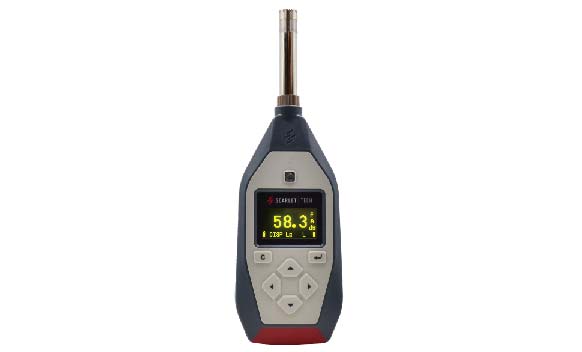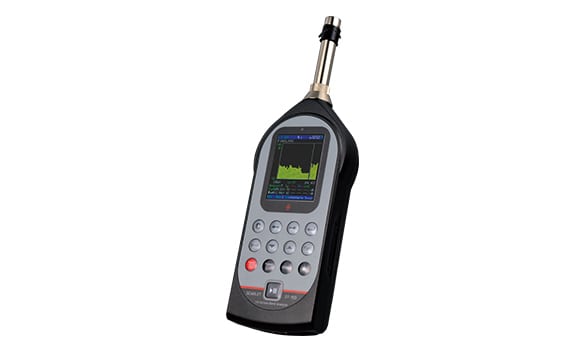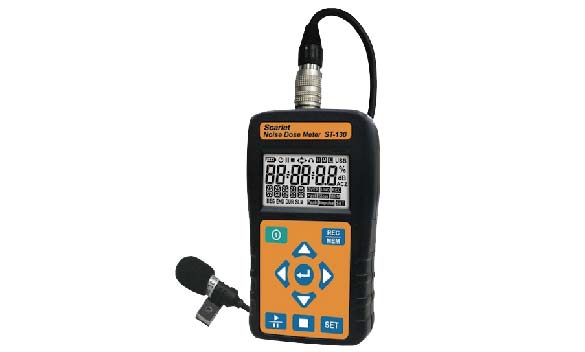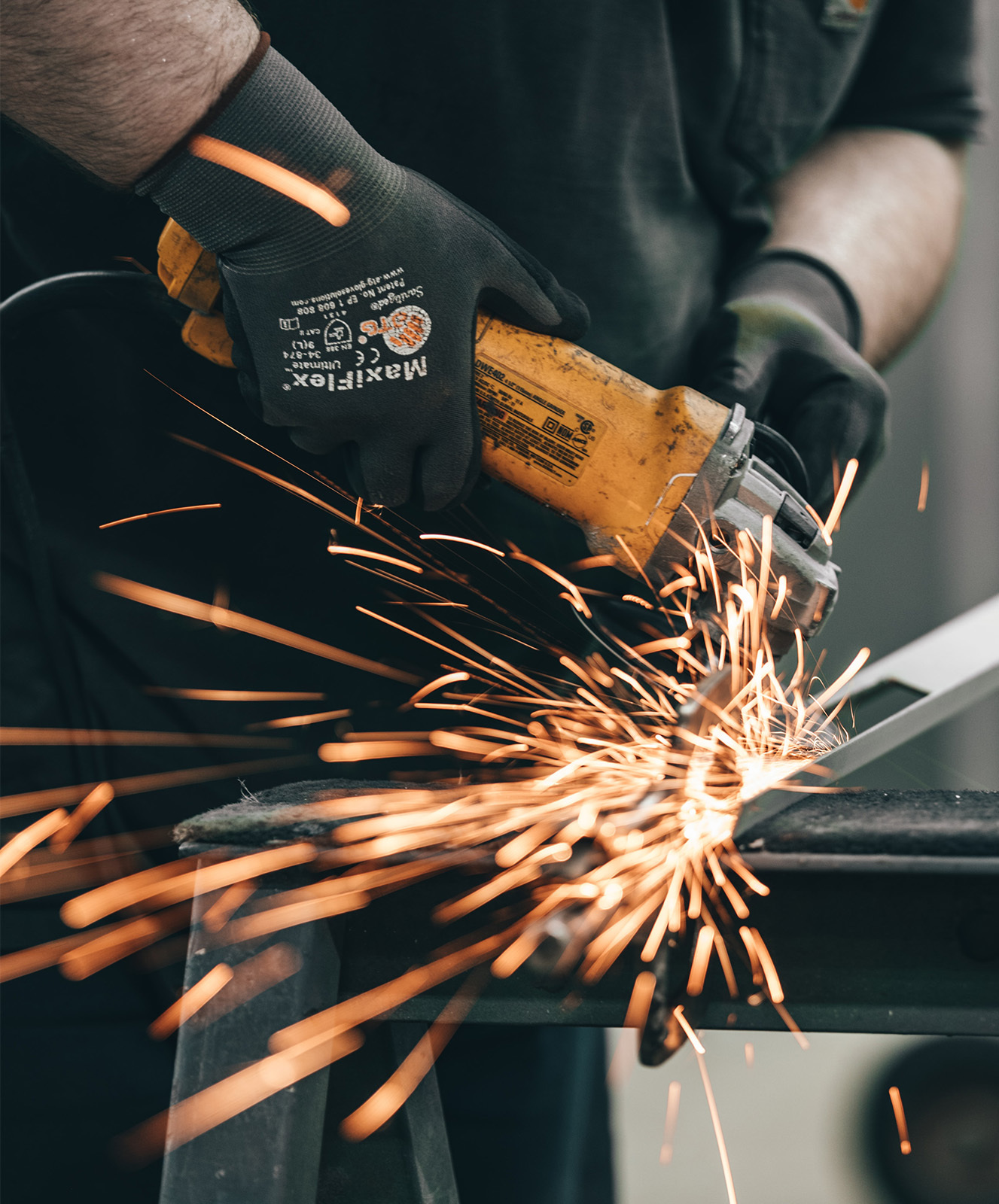What is Sound Level Meter?
A Sound Level Meter (SLM) is a compact portable instrument, usually battery-powered, used to measure sound-pressure levels directly while incorporating frequency weighting networks that approximate the inverse of equal loudness contours at various levels. A sound level meter is also called a sound pressure level meter (SPL). To understand what SPL is, we must first understand what “Sound Pressure” is.
What is Sound Pressure?
Sound pressure (p) is the average variation in atmospheric pressure caused by sound. The unit of pressure measurement is the pascal (Pa). Since it is not intuitive to use pascal (Pa) to refer to the volume of sound in our daily lives, it is easier to describe them in decibels. As a result, sound pressure (Pa) is typically converted into “sound pressure level” in decibels (dB) to represent the sound volume.
The conversion of “sound pressure” (Pa) to “sound pressure level” (dB) is as follows.
SPL = 20*Log10 ( P / Pref)
According to the International Standards (IEC 60942:2017), Sound Level Meter is categorized into two different classes based on its accuracy:
- Class 1—Precision grade with a tolerance of ±0.5 dB. It is ideal for industrial and laboratory use.
- Class 2—General purpose grade with a tolerance of ±1.0 dB. It is ideal for basic noise environmental measurements.
What is a normal sound level?
The World Health Organization (WHO) defines a “normal” sound level as anything below 35 decibels (dB). This is roughly equivalent to the noise of a whisper or rustling leaves. Above this threshold, any increase in loudness can cause stress, fatigue, and even hearing loss over time. For instance, levels above 85 dB are considered hazardous Noise pollution is a growing problem in our world, with sound levels above 35 dB potentially causing physical and mental health issues. WHO recommends keeping noise lower than 85dB to avoid the risk of hearing loss or fatigue over time. for human ears and may require protective equipment such as earplugs or headphones.
In many places worldwide, especially urban areas with traffic noise, normal sound levels often exceed these recommended thresholds. It is essential to understand how excessive noise affects us so that we can take measures to reduce its harmful impacts on our environment and ourselves.
How will you measure the sound level?
Measuring the sound level is essential to evaluate the acoustic environment of a particular space. Many different techniques and instruments are used to measure sound levels, including sound level meters, sound analyzers, and noise dosimeters.
Sound level meters measure the instantaneous sound pressure level in decibels (dB) and are usually used to determine the overall sound pressure level in a given area. Noise dosimeters measure an individual’s cumulative exposure over time and are often used to measure orientation in hazardous environments.
By measuring the sound levels of a particular area, it is possible to determine if the noise levels are suitable for workers and occupants. It can also be used to evaluate any unwanted noise space, we can decide if it is within an acceptable range or not. For example, if a sound level meter is used in an office environment and the results show that the sound level is too high, the table range is defined by local laws and regulations. Additionally, sound level measurements can help to identify areas where soundproofing may be necessary or beneficial.
What are the types of sound level meters?
There are three kinds of sound level meters based on how they measure the sound, the “conventional” sound level meter, the integrating-averaging sound level meter, and the integrating sound level meter.
Standard sound level meter
The standard sound level meter, also known as an exponentially averaging sound level meter, uses a root-mean-square (RMS) circuit to convert an AC signal from the microphone to a DC signal. Standard sound level meters are limited to determining the risk of hearing damage.
Integrating or integrating-averaging sound level meter
Since integrating and integrating-averaging sound level meters are functionally comparable, they are frequently grouped together. The integrating meter calculates sound exposure using pressure squared into time, in contrast to the conventional sound level meter, which adds frequency-weighted noise.
Integrating or integrating-averaging sound level meters, in contrast, is widely applied in occupational noise control and management.
How to Pick a Sound Level Meter?
First, one needs to determine what noise environment needs to be measured. Class 1 is more accurate but more expensive than Class 2. Some other additional features that may be considered are the octave band and octave band analysis. With the function of octave band and octave band analysis, one can export the NC curve and diagnose the noise source. Last but not least, time history recording is an essential feature if there is a need for signal analysis.
Find More Sound Level Meter
Class 1 Sound Level Meter ST-11D

• 10 Hz-20k Hz frequency range
• 27 dB-140 dB measurement range
• Stores 8000 groups measurement results including Timestamp, %Dose, TWA
• Data logging & record function(St-11D)
• Measures and displays Leq value
• Long term measurement
Class 1 Sound Analyzer ST-15D

• Wide measurement range: 20dB~142dB
• A / C / Z / B frequency weighting
• Working Temperature: -10 ~ 50°C
• Remote control through connected PC
Noise Dosimeter ST-130

• Perform OSHA and IEC noise accumulation surveys
• 6 built-in standard dose measurement setups: OSHA/ MSHA/DOD/ACGIH/ISO85/ISO90
• Data logger up to 10,00,000 readings
• Adjustable criterion level, exchange rate & threshold
• Sampling times between 1 sec to 2 hr
• Dose Meter Mode: record time stamp, %Dose, TWA8, LEP, 8h, Leq, SEL, LN%, SPLmax, SPLmin, PeakMAX
• Sound Level Meter mode: Leq, PeakMAX & SEL
Find More Sound Level Meter
ST-11/11D Class 1 Sound Level Meter

• 10 Hz-20k Hz frequency range
• 27 dB-140 dB measurement range
• Data logging & record function(St-11D)
• Measures and displays Leq value
• Long term measurement
ST-15D Class 1 Sound Analyzer Meter

• Wide measurement range: 20dB~142dB
• A / C / Z / B frequency weighting
• Working Temperature: -10 ~ 50°C
• Remote control through connected PC
ST-130 Noise Dosimeter

• 6 built-in standard dose measurement setups: OSHA/ MSHA/DOD/ACGIH/ISO85/ISO90
• Data logger up to 10,00,000 readings
• Adjustable criterion level, exchange rate & threshold
• Sampling times between 1 sec to 2 hr
• Stores up to 10,000 dose meter survey results
• Dose Meter Mode: record time stamp, %Dose, TWA8, LEP, 8h, Leq, SEL, LN%, SPLmax, SPLmin, PeakMAX
• Sound Level Meter mode: Leq, PeakMAX & SEL
• USB interface. Support Windows XP / Vista / 7 / 8
How Does Sound Level Meter Work?
The sound level meter consists of 3 main basic parts; a microphone, electronic circuits, and a display.The microphone contains a flexible membrane that detects small air pressure variations associated with sound and converts them into electrical signals. These signals are then processed using the electronic circuitry (see pict below), detected, and then displayed the sound level in decibels on the meter screen.
Standard sound level meters are designed to read the sound level with fast or slow exponential time averaging (IEC 60804:2000):
- Fast exponential time averaging has a 125 ms exponential time constant , that corresponds to the integration time of the ear (The human ear does not represent a linear system and does not register sounds with a duration less than 125 ms).
- Slow exponential time averaging has a 1s exponential time constant, that estimates the average noise level with a greater precision.

Why Do You Need Sound Level Meter?
PREVENT HEARING LOSS
According to The Center for Disease Control (CDC) ,about 22 million workers are exposed to potentially damaging noise at work each year..
Continuous exposure to loud noise kills the nerve endings in the inner ear. More exposure will result in more dead nerve endings which can result in permanent hearing loss. Permanent hearing loss is a forever existing condition that cannot be restored to normal condition through surgery, therapy, or with medicine. It limits the ability to hear and to understanding speech which seriously weaken your communication.
Whether you work at construction site, airport, or anywhere with loud noise , hearing loss is preventable through the use of tools such as Sound Level Meters- devices that measures sound levels and provides noise exposure parameters to help prevent hearing hazard.
Some others serious health issues caused by long-term high include the following:
- Heart Disease
- Hypertension
- Stress
- Sleep Trouble
SAFETY STANDARD
Under OSHA’s Noise Standard, when noise exposure is at or above 85 decibels averaged over 8 working hours, or an 8-hour time-weighted average (TWA), employers must reduce noise exposure to a safer levels according to its safety guideline. (Read more: hearing conservation program https://www.osha.gov/noise/hearing-programs)

Need More information about Class 1 Sound Level Meters?
A Class 1 Sound Level Meter is a noise measurement instrument that meets the requirements of IEC 61672-1:2002 (or an equivalent such as BS EN 61672-1:2003) to Class 1 performance. This standard specifies two levels of performance, Class 1 and Class 2, with Class 1 being effectively more accurate.

Scarlet Tech believe in identifying, building and nurturing long term distributor partnerships. We seek well run, established and properly resourced distributor partners that want to grow their business as much as we want to grow ours. If you or your company is up for a bulky order or being a distributor partner, please contact our sales team.

